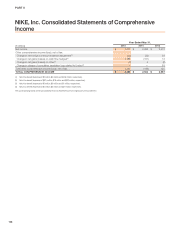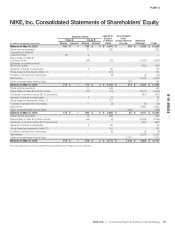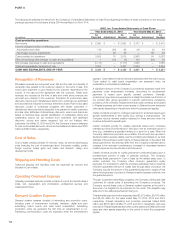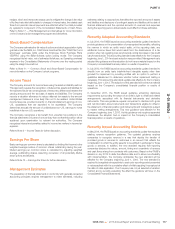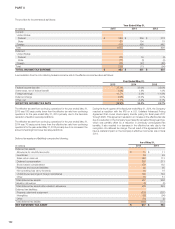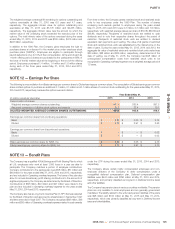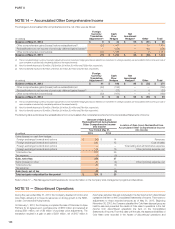Nike 2015 Annual Report Download - page 56
Download and view the complete annual report
Please find page 56 of the 2015 Nike annual report below. You can navigate through the pages in the report by either clicking on the pages listed below, or by using the keyword search tool below to find specific information within the annual report.
PART II
hedges, which are interest rate swaps used to mitigate the change in fair value
of its fixed-rate debt attributable to changes in interest rates, the related cash
flows from periodic interest payments are reflected within the Cash provided
by operations component of the Consolidated Statements of Cash Flows.
RefertoNote17—RiskManagementand Derivatives for more information
on the Company’s risk management program and derivatives.
Stock-Based Compensation
The Company estimates the fair value of options and stock appreciation rights
granted under the NIKE, Inc. 1990 Stock Incentive Plan (the “1990 Plan”) and
employees’ purchase rights under the Employee Stock Purchase Plans
(“ESPPs”) using the Black-Scholes option pricing model. The Company
recognizes this fair value, net of estimated forfeitures, as Operating overhead
expense in the Consolidated Statements of Income over the vesting period
using the straight-line method.
Refer to Note 11 — Common Stock and Stock-Based Compensation for
more information on the Company’s stock programs.
Income Taxes
The Company accounts for income taxes using the asset and liability method.
This approach requires the recognition of deferred tax assets and liabilities for
the expected future tax consequences of temporary differences between the
carrying amounts and the tax basis of assets and liabilities. The Company
records a valuation allowance to reduce deferred tax assets to the amount
management believes is more likely than not to be realized. United States
income taxes are provided currently on financial statement earnings of non-
U.S. subsidiaries that are expected to be repatriated. The Company
determines annually the amount of undistributed non-U.S. earnings to invest
indefinitely in its non-U.S. operations.
The Company recognizes a tax benefit from uncertain tax positions in the
financial statements only when it is more likely than not that the position will be
sustained upon examination by relevant tax authorities. The Company
recognizes interest and penalties related to income tax matters in Income tax
expense.
Refer to Note 9 — Income Taxes for further discussion.
Earnings Per Share
Basic earnings per common share is calculated by dividing Net income by the
weighted average number of common shares outstanding during the year.
Diluted earnings per common share is calculated by adjusting weighted
average outstanding shares, assuming conversion of all potentially dilutive
stock options and awards.
RefertoNote12—EarningsPerShareforfurtherdiscussion.
Management Estimates
The preparation of financial statements in conformity with generally accepted
accounting principles requires management to make estimates, including
estimates relating to assumptions that affect the reported amounts of assets
and liabilities and disclosure of contingent assets and liabilities at the date of
financial statements and the reported amounts of revenues and expenses
during the reporting period. Actual results could differ from these estimates.
Recently Adopted Accounting Standards
In July 2013, the FASB issued an accounting standards update intended to
provide guidance on the presentation of unrecognized tax benefits, reflecting
the manner in which an entity would settle, at the reporting date, any
additional income taxes that would result from the disallowance of a tax
position when net operating loss carryforwards, similar tax losses or tax credit
carryforwards exist. This accounting standard was effective for the Company
beginning June 1, 2014 and early adoption was permitted. Management early
adopted this guidance and the adoption did not have a material impact on the
Company’s consolidated financial position or results of operations.
In July 2012, the FASB issued an accounting standards update intended to
simplify how an entity tests indefinite-lived intangible assets other than
goodwill for impairment by providing entities with an option to perform a
qualitative assessment to determine whether further impairment testing is
necessary. This accounting standards update was effective for the Company
beginning June 1, 2013. The adoption of this standard did not have a material
impact on the Company’s consolidated financial position or results of
operations.
In December 2011, the FASB issued guidance enhancing disclosure
requirements surrounding the nature of an entity’s right to offset and related
arrangements associated with its financial instruments and derivative
instruments. This new guidance requires companies to disclose both gross
and net information about instruments and transactions eligible for offset in
the statement of financial position and instruments and transactions subject
to master netting arrangements. This new guidance was effective for the
Company beginning June 1, 2013. As this guidance only requires expanded
disclosures, the adoption had no impact on the Company’s consolidated
financial position or results of operations.
Recently Issued Accounting Standards
In May 2014, the FASB issued an accounting standards update that replaces
existing revenue recognition guidance. The updated guidance requires
companies to recognize revenue in a way that depicts the transfer of
promised goods or services to customers in an amount that reflects the
consideration to which the entity expects to be entitled in exchange for those
goods or services. In addition, the new standard requires that reporting
companies disclose the nature, amount, timing and uncertainty of revenue
and cash flows arising from contracts with customers. Based on the FASB’s
decision in July 2015 to defer the effective date and to allow more flexibility
with implementation, the Company anticipates the new standard will be
effective for the Company beginning June 1, 2018. The new standard is
required to be applied retrospectively to each prior reporting period presented
or retrospectively with the cumulative effect of initially applying it recognized at
the date of initial application. The Company has not yet selected a transition
method and is currently evaluating the effect the guidance will have on the
Consolidated Financial Statements.
NIKE, INC. 2015 Annual Report and Notice of Annual Meeting 117
FORM 10-K



